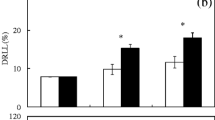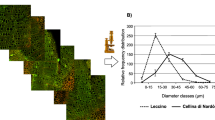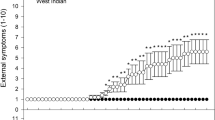Abstract
Permanent xylem blockage is a common result of attacks by herbivores and fungi. The mitosporic fungus Phoma tracheiphila (Petri) Kantschaveli et Gikachvili, is the agent of a Citrus tracheomycosis (“malsecco disease”) causing xylem impairment and leading to leaf shedding and plant dieback. In the present study, this pathogen was used for monitoring the effects of increasing levels of stem hydraulic resistance (R stem) on leaf water status and gas exchange. In this view, measurements are reported of changes in the hydraulic resistance of infected stems (R stem) of C. aurantium (sour orange) during progressive and irreversible xylem blockage with parallel measurements of leaf water potential and conductance to water vapour. Leaves were highly responsive to increasing R stem as due to fungal infection, with substantial stomatal closure and drop in water potential.




Similar content being viewed by others
References
Ameglio TC, Bodet A, Lacointe A, Cochard H (2002) Winter embolism, mechanisms of xylem hydraulic conductivity recovery and springtime growth patterns in walnut and peach trees. Tree Physiol 22:1211–1230
Andersen PC, Brodbeck BV, Mizell RF (1992) Feeding by the leafhopper Homalodisca coagulata in relation to xylem fluid chemistry and tension. J Insect Physiol 38(8):611–622
Balmas V, Scherm B, Ghignone S, Salem AOM, Cacciola SO, Migheli Q (2005) Characterisation of Phoma tracheiphila by RAPD-PCR, microsatellite-primed PCR and ITS rDNA sequencing and development of specific primers for in planta PCR detection. Eur J Plant Pathol 111:235–247
Bucci SJ, Scholz FG, Goldstein G, Meinzer FC, Sternberg LDSL (2003) Dynamic changes in hydraulic conductivity in petioles of two savanna species: factors and mechanisms contributing to the refilling of embolized vessels. Plant Cell Environ 26:1633–1645
Cochard H, Cruiziat P, Tyree MT (1992) Use of positive pressures to establish vulnerability curves. Further support for the air-seeding hypothesis and implications for pressure-volume analysis. Plant Physiol 100:205–209
Cochard H, Froux F, Mayr S, Coutand C (2004) Xylem wall collapse in water-stressed pine needles. Plant Physiol 134:401–408
Crews LJ, McCully ME, Canny MJ, Huang CX, Ling LEC (1998) Xylem feeding by spittlebug nymphs: some observations by optical and cryo-scanning electron microscopy. Am J Bot 85:449–460
De Lorenzo G, Ferrari S (2002) Polygalacturonase-inhibiting proteins in defense against phytopathogenic fungi. Curr Opin Plant Biol 5:295–299
De Lorenzo G, D’Ovidio R, Cervone F (2001) The role of polygalacturonase-inhibiting proteins (PGIPs) in defense against pathogenic fungi. Annu Rev Phytopathol 39:313–335
Delaney KJ, Higley LG (2006) An insect countermeasure impacts plant physiology: midrib vein cutting, defoliation and leaf photosynthesis Plant. Plant Cell Environ 29(7):1245–1258
Demontis MA, Cacciola SO, Orrù M, Balmas V (2008) Development of real-time PCR systems based on SYBR® Green I and TaqMan® technologies for specific quantitative detection of Phoma tracheiphila in infected Citrus. Eur J Plant Pathol 120:339–351
Esquerre-Tugaye MT, Boudart G, Dumas B (2000) Cell wall degrading enzymes, inhibitory proteins, and oligosaccharides participate in the molecular dialogue between plants and pathogens. Plant Physiol Biochem 38(1):157–163
Fahn A (1990) Plant anatomy. Butterworth-Heinemann, Oxford
Gascò A, Nardini A, Gortan E, Salleo S (2006) Ion-mediated increase in the hydraulic conductivity of Laurel stems: role of pits and consequences for the impact of cavitation on water transport. Plant Cell Environ 29:1946–1955
Lo Gullo MA, Salleo S (1993) Different vulnerabilities of Quercus ilex L. to freeze- and summer drought-induced xylem embolism: an ecological interpretation. Plant Cell Environ 16:511–519
Magnano di San Lio G, Cacciola SO, Pane A, Grasso S (1992) Relationship between xylem colonization and symptom expression in mal secco infected sour orange seedlings. Proc Int Soc Citric 2:873–876
Meinzer FC (2002) Co-ordination of vapour and liquid phase water transport properties in plants. Plant Cell Environ 25:265–274
Mercado-Blanco J, Collado-Romero M, Parrilla-Araujo S, Rodriguez-Jurado D, Jimenez-Diaz R (2003) Quantitative monitoring of colonization of olive genotypes by Verticillium dahliae pathotypes with real-time polymerase chain reaction. Physiol Mol Plant Pathol 63:91–105
Nardini A (2001) Are sclerophylls and malacophylls hydraulically different? Biol Plant 44:239–245
Nardini A, Salleo S (2003) Effects of the experimental blockage of the major veins on hydraulics and gas exchange of Prunus laurocerasus L. leaves. J Exp Bot 54:1213–1219
Nardini A, Gascò A, Trifilò P, Lo Gullo MA, Salleo S (2007) Ion-mediated enhancement of xylem hydraulic conductivity is not always suppressed by the presence of Ca2+ in the sap. J Exp Bot 58:2609–2615
Perrotta G, Magnano di San Lio G, Bassi M (1979) Some anatomical and morpho-functional aspects of resistance to Phoma tracheiphila in citrus plants. Phytopathologische Zeitschrift 98:346–358
Raimondo F, Ghirardelli LA, Nardini A, Salleo S (2003) Impact of the leaf miner Cameraria ohridella on photosynthesis, water relations and hydraulics of Aesculus hippocastanum leaves. Trees—structure and function 17:376–382
Raimondo F, Raudino F, Cacciola SO, Salleo S, Lo Gullo Ma (2007) Impariment of leaf hydraulics in young plants of Citrus aurantium (sour orange) infected by Phoma tracheiphila. Funct Plant Biol 34:720–729
Sack L, Dietrich EM, Streeter CM, Sànchez-Gòmez D, Hobrook NM (2008) Leaf palmate venation and vascular redundancy confer tolerance of hydraulic disruption. Proc Natl Acad Sci USA 105:1567–1572
Salleo S, Nardini A, Pitt F, Lo Gullo MA (2000) Xylem cavitation and hydraulic control of stomatal conductance in laurel (Laurus nobilis L.). Plant Cell Environ 23:71–79
Salleo S, Raimondo F, Trifilò P, Nardini A (2003) Axial-to-radial water permeability of leaf major veins: a possible determinant of the impact of vein embolism on leaf hydraulics? Plant Cell Environ 26:1749–1758
Salleo S, Lo Gullo MA, Trifilò P, Nardini A (2004) New evidence for a role of vessel-associated cells and phloem in the rapid xylem refilling of Laurus nobilis L. cavitated stems. Plant Cell Environ 27:1065–1066
Sperry JS (2000) Hydraulic constraints on plant gas exchange. Agric For Meteorol 104:13–23
Sperry JS, Perry AH, Sullivan JEM (1991) Pit membrane degradation and air-embolism formation in ageing xylem vessels of Populus tremuloides Michx. J Exp Bot 42:1399–1406
Sperry JS, Stiller V, Hacke UG (2003) Xylem hydraulics and the soil-plant-atmosphere continuum: opportunities and unresolved issues. Agron Journal 95:1362–1370
Stiller V, Sperry JS, Lafitte HR (2005) Embolized conduits of rice (Oryza sativa L., Poaceae) refill despite negative xylem pressure. Am J Bot 92:1970–1974
Trifilò P, Lo Gullo MA, Salleo S, Callea K, Nardini A (2008) Xylem embolism can be alleviated by ion-mediated increase in hydraulic conductivity of functional xylem: insights from field measurements. Tree Physiol 28:1505–1512
Tyree MT, Cochard H (1996) Summer and winter embolism in oak: impact on water relations. Annales Des Sciences Forestiéres 53:173–180
Tyree MT, Zimmermann MH (2002) Xylem structure and the ascent of sap. Springer, Berlin
Tyree MT, Patiño S, Bennink J, Alexander J (1995) Dynamic measurements of roots hydraulic conductance using a high-pressure flow meter in the laboratory and field. J Exp Bot 46:83–94
Watson R, Pritchard J, Malone M (2001) Direct measurement of sodium and potassium in the transpiration stream of salt-excluding and non-excluding varieties of wheat. J Exp Bot 52:1873–1881
Wheeler JK, Sperry JS, Hacke UG, Hoang N (2005) Inter-vessel pitting and cavitation in woody Rosaceae and other vesselled plants: a basis for a safety versus efficiency trade-off in xylem transport. Plant Cell Environ 28:800–812
Zimmermann MH (1983) Xylem structure and the ascent of sap. Springer, New York
Zwieniecki MA, Melcher PJ, Holbrook NM (2001) Hydrogel control of xylem hydraulic resistance in plants. Science 291:1059–1062
Zwieniecki MA, Melcher PJ, Boyce CK, Sack L, Holbrook NM (2002) Hydraulic architecture of leaf venation in Laurus nobilis L. Plant Cell Environ 25:1445–1450
Acknowledgments
We thank Professor G. Magnano di San Lio for giving us Phoma tracheiphila conidia from his cultures as well as for helpful suggestions and stimulating discussions.
Author information
Authors and Affiliations
Corresponding author
Additional information
Communicated by H. Cochard.
Rights and permissions
About this article
Cite this article
Raimondo, F., Nardini, A., Salleo, S. et al. A tracheomycosis as a tool for studying the impact of stem xylem dysfunction on leaf water status and gas exchange in Citrus aurantium L.. Trees 24, 327–333 (2010). https://doi.org/10.1007/s00468-009-0402-4
Received:
Revised:
Accepted:
Published:
Issue Date:
DOI: https://doi.org/10.1007/s00468-009-0402-4




